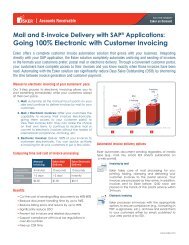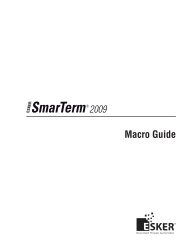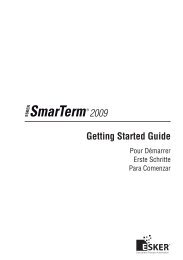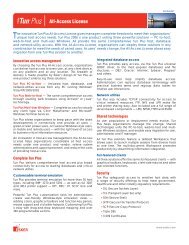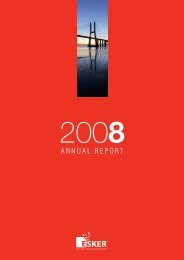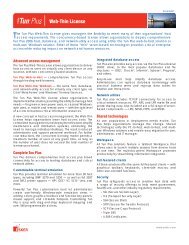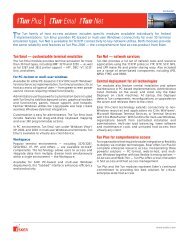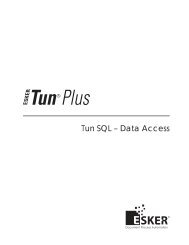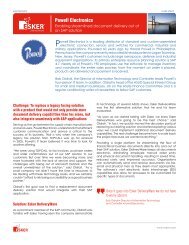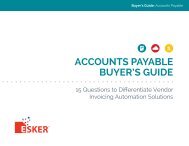Automating Sales Order Management with SaaS - Esker
Automating Sales Order Management with SaaS - Esker
Automating Sales Order Management with SaaS - Esker
You also want an ePaper? Increase the reach of your titles
YUMPU automatically turns print PDFs into web optimized ePapers that Google loves.
white paper<br />
<strong>Automating</strong> <strong>Sales</strong><br />
<strong>Order</strong> <strong>Management</strong><br />
<strong>with</strong> <strong>SaaS</strong><br />
to Improve <strong>Order</strong>-to-Cash<br />
Performance<br />
www.esker.com
<strong>Esker</strong> on Demand<br />
white paper<br />
Table of Contents<br />
Introduction........................................................................................................................................................................................3<br />
Paper Problems.................................................................................................................................................................................4<br />
Automation Advantages.................................................................................................................................................................5<br />
Why <strong>SaaS</strong> for <strong>Sales</strong> <strong>Order</strong> Processing.....................................................................................................................................7<br />
Plugging In to <strong>Esker</strong> on Demand.................................................................................................................................................9<br />
Solution Example: Healthcare Products Co.............................................................................................................................9<br />
About <strong>Esker</strong>......................................................................................................................................................................................13<br />
2
<strong>Esker</strong> on Demand<br />
white paper<br />
Introduction<br />
<strong>Order</strong> management realities<br />
In studies conducted by IT industry analyst IDC, financial directors have estimated that the annual cost of processing<br />
order management documents represents between 5 and 15 percent of sales. Automated sales order processing offers<br />
cost savings and operational efficiencies that make companies better equipped to be competitive and profitable in a<br />
challenging business environment.<br />
In the age of e-commerce, most companies have instituted some measure of automation <strong>with</strong>in customer order<br />
management. Many even consider their processes to be completely electronic. The reality is, nearly all businesses still have<br />
manual touch points in sales order processing. EDI, XML and Web technologies may automate at least parts of the process<br />
in the majority of customer order transactions, but what about the rest<br />
The ability to treat every customer as an “e-customer” can close a costly gap in overall business performance. Even<br />
orders that are received electronically often end up as paper on someone’s desk. Although paper is familiar and many<br />
companies have become experts at working <strong>with</strong> it in their customer order processes, continued reliance on paper has<br />
no value and will only limit an organization’s ability to improve performance. At every manual touch point in processing,<br />
companies lose the transparency that provides a view of daily activities for effective order management.<br />
When companies examine ways to cut costs and improve profitability, optimizing customer order processing <strong>with</strong>in the<br />
order-to-cash cycle often holds the highest potential for gains. High performance in order management is probably the<br />
one characteristic that distinguishes top-performing companies more than any other. Automation enables companies to<br />
quit paper, gain efficiencies and achieve peak performance.<br />
According to research by IT industry analyst IDC, businesses clearly recognize the benefits of document process automation<br />
for sales order management.<br />
• Improved productivity of individual employees and the company as a whole<br />
• Increased competitiveness for the business<br />
• Improved cost management and cash flow as a result of reducing customer order processing and storage costs<br />
• Reduction in the number of errors and returns causing order-to-cash delays<br />
• Increased customer satisfaction from on-time delivery, order tracking ability and responsiveness to customer requests<br />
But another reality of order management is the expense and complexity of implementing software for comprehensive,<br />
enterprise-wide automation can be an obstacle to putting a solution in place. This has made the Software as a Service<br />
(<strong>SaaS</strong>) model an increasingly attractive option. With the advancement of <strong>SaaS</strong> technologies, on-demand solutions have<br />
become more prevalent. Gartner Group estimated the <strong>SaaS</strong> market at $6.4 billion in 2008 and projected a likely doubling<br />
of the market by 2012.1<br />
<strong>SaaS</strong> delivers the benefits<br />
Today all the benefits of automated sales order processing are available through the <strong>SaaS</strong> model. Essentially, all you<br />
need is an Internet connection to deploy a powerful solution across the entire enterprise. <strong>SaaS</strong> offers the opportunity to<br />
integrate end-to-end automation <strong>with</strong> existing processes, spanning the document lifecycle from receipt and capture to<br />
workflow, archiving and retrieval. In working <strong>with</strong> a diverse range of businesses to automate sales order processing, <strong>Esker</strong><br />
has found that companies typically cut operational and administration costs by 40 to 60 percent <strong>with</strong> <strong>Esker</strong> on Demand<br />
<strong>SaaS</strong> solutions.<br />
As a resource to assist CEOs, CFOs, CIOs, managers and administrators in evaluating <strong>SaaS</strong> for sales order management,<br />
this paper presents a solution that leverages comprehensive document process automation to deliver the advantages of<br />
paperless order processing as an on-demand service. It highlights the opportunity to shift ROI from the project level to the<br />
document level (capital versus operational expense) and realize automation benefits immediately.<br />
1<br />
Guseva, Irina. “Gartner: <strong>SaaS</strong> is Hot, Revenue Will Keep Rising.” CMSWire, October 28, 2008.<br />
3
<strong>Esker</strong> on Demand<br />
white paper<br />
Paper Problems<br />
Manual touch points<br />
When a company receives customer purchase orders, the process of entering data, handling approval workflow and<br />
creating sales orders can determine how much efficiency the company is capable of achieving. Manual processing of<br />
sales orders is inherently labor-intensive, time-consuming and error-prone, requiring valuable resources to manage each<br />
part of the process.<br />
In many companies, sales orders travel through a maze of manual touch points. Paper documents are collected from a<br />
fax machine or printer; collated, copied and filed. Key information like sold-to number, quantities and part numbers is often<br />
entered by hand. Once the information is entered, there are issues of how to handle exceptions. And when customers call<br />
to check the status of their orders, reps have to track down the paper. The process of preparing, entering and storing a<br />
single paper order can take hours, and managers can only hope that none of these touch points cause misplaced orders,<br />
delays in fulfillment and payment, errors and returns that drive customer dissatisfaction and loss of business.<br />
Production<br />
Shipping<br />
Accounting<br />
Department<br />
<strong>Order</strong> Confirmation by Fax<br />
To be<br />
archived<br />
Delivery Bill Copy<br />
Goods & Delivery Bill<br />
Customer<br />
<strong>Sales</strong><br />
<strong>Order</strong><br />
Verification &<br />
manual entry<br />
of content<br />
SAP ® Applications<br />
Invoice<br />
Customers<br />
<strong>Sales</strong> <strong>Order</strong><br />
Copy<br />
Invoice<br />
Copy<br />
To be<br />
archived<br />
<strong>Sales</strong><br />
Department<br />
To be<br />
archived<br />
<strong>Sales</strong><br />
Department<br />
Manual Touch Point<br />
Prioritizing<br />
Manual processing typically does not allow for prioritizing of sales orders according to customer or product line. To achieve<br />
the highest levels of service, companies need to be able to identify and keep these special orders.<br />
Archiving<br />
Companies also spend a significant amount of time retrieving orders and order data for internal or external audits and<br />
to satisfy regulatory compliance requirements. Further complicating these tasks is the risk of paper orders getting lost or<br />
misfiled.<br />
Accuracy<br />
Reprocessing a single order due to error or document loss can cost as much as $200. In addition to delaying fulfillment,<br />
order errors often result in extra shipping costs, wasted materials, credit notes, restocking fees and even write-offs.<br />
4
<strong>Esker</strong> on Demand<br />
white paper<br />
Automation Advantages<br />
<strong>Order</strong>-to-cash efficiency<br />
Along <strong>with</strong> reducing operational costs, freeing staff time for customer service activities and improving accuracy, automated<br />
sales order processing gives companies clear insight into what is happening on a daily basis. These factors help companies<br />
better manage customer relationships, manage inventory and production, comply <strong>with</strong> regulatory requirements, control<br />
finances and sales forecasting and improve overall profitability. Automation offers rich functionality to streamline and<br />
automate the process of capturing, submitting, approving and fulfilling customer orders to reduce order processing time,<br />
help ensure accuracy and control, and provide real-time visibility of each order in the process.<br />
<strong>Sales</strong> <strong>Order</strong> Process Audit Trail<br />
RECEIVE<br />
PREPARE<br />
RECOGNIZE<br />
CAPTURE<br />
MANAGE CREATE SHIP<br />
Email<br />
Fax<br />
Batch prep.<br />
Scan<br />
Extract data<br />
Validate<br />
Clear exception<br />
Comments<br />
Create<br />
Archive image<br />
Release<br />
for shipping<br />
Mail<br />
Split<br />
Complete<br />
Enhance<br />
Business process management<br />
<strong>Esker</strong> DeliveryWare <strong>Esker</strong> DeliveryWare / SAP SAP<br />
Automated sales order processing solutions can be valuable tools for effective business process management <strong>with</strong> realtime<br />
budget control, order validation and automated approval workflow. Customer service gains the ability to see what<br />
and where every order is at any given time. Combined <strong>with</strong> flexible user rights management features, these capabilities<br />
can also help companies comply <strong>with</strong> regulations such as the Sarbanes-Oxley Act.<br />
Automation can enable managers and staff to monitor average order processing time, orders processed per FTE, order<br />
volume per hour, day or week; order volume by customer, product or line of business; and other Key Performance Indicators.<br />
And whether a company uses the technology to remove some or all human intervention from sales order processing, an<br />
automated process offers distinct advantages <strong>with</strong> electronic copies of orders readily available to any authorized person<br />
<strong>with</strong>in the company — eliminating the need to sift through physical files.<br />
Key financial management benefits of automating all of these areas include real-time budget control, sales monitoring<br />
and forecasting. This level of automation enables companies to:<br />
• Increase order processing speed by up to 90%<br />
• Reduce order-to-cash operational costs by up to 70%<br />
• Reduce data entry costs by $4–$12 per order<br />
• Gain a clear view into the process and improve responsiveness <strong>with</strong> 100% visibility of all orders<br />
• Realize rapid return on investment in as little as 3–6 months<br />
5
<strong>Esker</strong> on Demand<br />
white paper<br />
Balancing and scaling workload<br />
Automated sales order processing can create a more flexible and scalable workforce by managing resources in response<br />
to fluctuating order volumes and changing business trends. In addition, many companies need to be able to redistribute<br />
order processing operations on a global basis, and an automated solution can provide the ability to shift processing to<br />
another site if a disaster occurs. Also, because volume of orders for some products are subject to seasonal demand or other<br />
business trends, certain reps may receive much higher order loads than others at different times of the year, automation<br />
helps by providing reporting capability to track order volumes and enable shifting of staff to different product lines.<br />
Cutting costs<br />
From a business standpoint, the bottom-line driver for automation of sales order processing is substantial savings of time<br />
and money. Estimated total cost associated <strong>with</strong> automated sales order process flow ranges from $1 to $3, compared <strong>with</strong><br />
$30 to $60 for manual process flow.<br />
Effectively taking paper out of the process, automation reduces the time from receipt of a sales order to payment of the<br />
invoice. Savings result from:<br />
• Increasing the percentage of orders and order line items captured electronically<br />
• Preventing lost or misplaced orders by keeping them electronic<br />
• Lowering stored data costs through electronic archiving<br />
• Freeing-up staff time by as much as 65% so they can focus more on customer service<br />
• Increasing data entry accuracy by up to 99%<br />
• Reducing returns, which directly affects the bottom line<br />
6
<strong>Esker</strong> on Demand<br />
white paper<br />
Why <strong>SaaS</strong> for <strong>Sales</strong> <strong>Order</strong> Processing<br />
Automation at your service<br />
As an alternative to hosting an order management automation solution in-house or outsourcing a revenue-generating<br />
process, a <strong>SaaS</strong> approach helps to preserve capital by automating sales order processing <strong>with</strong>out the risks of outsourcing,<br />
additional IT complexity or associated expenditures:<br />
• No software or hardware<br />
• No maintenance<br />
• No loss of control<br />
<strong>Sales</strong> order is<br />
Verification is <strong>Sales</strong> order<br />
1 2 submitted<br />
done through 3 <strong>Sales</strong> order<br />
is routed to<br />
is passed to 5<br />
<strong>Order</strong> data<br />
and image are<br />
web application staff for approval manager for final passed to ERP<br />
sign-off<br />
<strong>Sales</strong> <strong>Order</strong><br />
<strong>SaaS</strong> offers the opportunity to implement automated sales order processing rapidly and cost-effectively, <strong>with</strong>out the need<br />
to build or expand an in-house network. Mature <strong>SaaS</strong> models can put the most powerful automation technologies at an<br />
organization’s disposal, so the enterprise can dynamically adapt to new business challenges and deploy solutions quickly.<br />
Companies get the capabilities expected from an on-premise software solution, but move from capital to operational<br />
expenditure and gain flexibility for variations in document volume and number of users.<br />
With a <strong>SaaS</strong> solution, fax, email or web sales orders can enter into an automated workflow for approval upon receipt.<br />
<strong>Order</strong>s can be dispatched to the appropriate business units where staff receive timely alerts that prompt them to sign-off<br />
on documents. Each order can be processed according to business rules for specified document attributes. Every step of<br />
the workflow process can documented, and all documents can be automatically archived and retrieved immediately for<br />
reference or auditing.<br />
With the right <strong>SaaS</strong> solution:<br />
• Users anywhere in an organization can leverage the automation platform at any time to process customer orders<br />
efficiently and consistently<br />
• Geographically separate business units can all share in the benefits of visibility, tight controls, support for effective order<br />
management and operational cost reduction<br />
• Services can be customized easily so that each user only has access to the components he or she needs<br />
• Minimal implementation cost brings the benefits of automated sales order processing to organizations of any size — so<br />
small and medium businesses can gain process efficiencies once practical only for large corporations<br />
• Managers can accelerate execution of sales order automation projects <strong>with</strong>out the need for deep involvement of IT<br />
resources or large budget allowances for implementation cost<br />
Simply put, <strong>SaaS</strong> solutions can enable more people throughout the organization to operate more effectively when it comes<br />
to sales order processing. The web-based nature of a <strong>SaaS</strong> approach allows enterprises to expand automated order entry<br />
and approval workflow beyond the walls of the company — to subsidiary offices, remote employees, manufacturing<br />
facilities, and other locations — <strong>with</strong> best-of-breed security and no need to open the corporate firewall.<br />
7
<strong>Esker</strong> on Demand<br />
white paper<br />
Fax-to-order<br />
Fax continues to be a medium of choice for customer orders — and<br />
a source of pain for businesses. Nearly every company has a certain<br />
percentage of customers who want to fax their orders, often because<br />
they are unwilling or unable to use EDI. While companies need reliable<br />
faxing capabilities to keep business processes running, most are not<br />
interested in supporting the required infrastructure. Fax hardware<br />
and software can be time-consuming to manage and expensive to<br />
support.<br />
FAX SERVER<br />
harDware PUrChase 6%<br />
sOFtware LICense<br />
maIntenanCe<br />
10%<br />
25%<br />
FAX SERVICE<br />
InItIaL set-UP<br />
Per PaGe Fee<br />
28%<br />
72%<br />
<strong>SaaS</strong> offers a cost-effective way to:<br />
• Ensure reliable fax <strong>with</strong> a solution that is transparent to users<br />
ImPLementatIOn<br />
& CUstOmIZatIOn<br />
33%<br />
• Let IT staff focus on process improvement instead of fax server<br />
configuration and maintenance<br />
• Support change control and business continuity by limiting the effect<br />
of changes like ERP upgrades on faxing systems, and avoiding<br />
downtime <strong>with</strong> around-the-clock monitoring<br />
traInInG<br />
teLCO COst<br />
10%<br />
19%<br />
H I D D E N C O S T S<br />
H I D D E N C O S T S<br />
Compared <strong>with</strong> <strong>SaaS</strong>, the costs of using a fax server go far beyond software and hardware. Fax services eliminate the<br />
hidden costs of relying on a fax server. There are no start-up costs and the service is simple to use, <strong>with</strong> no real training<br />
involved. It can be easily integrated <strong>with</strong> existing business systems and there is nothing to install.<br />
Safe <strong>SaaS</strong><br />
Companies are well-advised to proceed <strong>with</strong> caution because <strong>SaaS</strong> outcomes are dependent upon the provider’s<br />
ability to safeguard network connections and information flow. Data privacy, access control, and business continuity<br />
are key considerations for any company in choosing a <strong>SaaS</strong> provider. Top-tier <strong>SaaS</strong> facilities combine physical and virtual<br />
infrastructure to secure enterprise information <strong>with</strong>in and outside the walls of the organization, providing the necessary<br />
elements to ensure the highest levels of protection, including:<br />
• Data security and confidentiality safeguards including key card entry, biometric recognition, digital surveillance, and<br />
secure protocols (HTTPS, SFTP, SSL)<br />
• Access control <strong>with</strong> password protection, folder- and document-level restriction to specific users or groups, identity<br />
administration, role management and user provisioning<br />
• Reliability and scalability <strong>with</strong> 24/7x365 system monitoring, infrastructure redundancy and multitenant architecture<br />
• Availability <strong>with</strong> redundant disk array subsystem, clustering and load balancing, backup electrical generators, active/<br />
passive fire prevention measures and temperature control for humidity and pressure<br />
• Recovery <strong>with</strong> data tape backup, data replication and synchronization in multiple locations, and failover capabilities<br />
Fast deployment<br />
Because there is no server or desktop computer setup and limited Internet access, a <strong>SaaS</strong> application can be up and<br />
running quickly. Following initial sign-up and system configuration to match your internal process, users and permissions are<br />
set up, data is uploaded, and your staff is trained.<br />
8
<strong>Esker</strong> on Demand<br />
white paper<br />
Plugging In to <strong>Esker</strong> on Demand<br />
Power of the platform<br />
Long before the current boom in <strong>SaaS</strong> adoption, <strong>Esker</strong> identified <strong>SaaS</strong> as<br />
the best way to make the “quit paper” benefits of automated document<br />
processing readily accessible to organizations of all sizes in all industries. Over<br />
the past decade <strong>Esker</strong> has brought together technologies and integration<br />
services to offer high-value <strong>SaaS</strong> solutions, and today <strong>Esker</strong> on Demand<br />
services run critical business processes for thousands of organizations around<br />
the world, processing millions of documents a month.<br />
Leveraging advanced technology<br />
At the heart of <strong>Esker</strong> on Demand is patented business rules engine technology<br />
that can automate virtually any paper-based business process in any type of<br />
organization.<br />
<strong>Esker</strong> on Demand solutions offer imaging and workflow automation capabilities<br />
that go beyond basic OCR to analyze content and execute processing<br />
based on business rules governing distribution, and are not dependent upon<br />
templates or specific document formats. Data is automatically captured<br />
Hosted Infrastructure<br />
E-Invoicing<br />
XML<br />
Web<br />
and analyzed using this intelligent technology to eliminate manual data entry. Resulting documents can be formatted and<br />
delivered to multiple destinations via any combination of transport media. The original document image is automatically<br />
stored for retrieval as needed.<br />
E-Purchasing<br />
<strong>Sales</strong> <strong>Order</strong> Processing<br />
Business Rules Engine<br />
Document Process Automation<br />
Accounts Payable<br />
Document Manager<br />
INTEGRATION SERVICES<br />
Document Capture<br />
Content <strong>Management</strong><br />
Workflow Engine<br />
Audit & Security<br />
Administration<br />
Fax<br />
Email<br />
SMS<br />
Postal Mail<br />
Archive<br />
Fax<br />
Email<br />
ERP<br />
Web<br />
Publishing<br />
Capture<br />
Applications<br />
CRM<br />
Scan<br />
Content Analysis<br />
Workflow<br />
Content Formatting<br />
Delivery<br />
Customers — Vendors<br />
Partners — Employees<br />
Fax and Email<br />
Electronic<br />
Archive<br />
Print<br />
9
<strong>Esker</strong> on Demand<br />
white paper<br />
<strong>Esker</strong> on Demand <strong>Sales</strong> <strong>Order</strong> Processing<br />
Developed to make automation benefits easily accessible to companies of all sizes, and to lighten the load for those in<br />
customer service, sales administration and other departments who handle customer orders, <strong>Esker</strong> on Demand takes an<br />
innovative approach to automation of order processing from receipt to archiving. The service is based on a pay-perdocument<br />
model and places a leading-edge business application in the hands of the user <strong>with</strong>out the expense of<br />
traditional software implementation. Companies choose <strong>Esker</strong> on Demand <strong>Sales</strong> <strong>Order</strong> Processing for quick and simple<br />
deployment, low cost of acquisition, ease of use and immediate return on investment.<br />
Visibility and control gained <strong>with</strong> <strong>Esker</strong> on Demand <strong>Sales</strong> <strong>Order</strong> Processing offers significant benefits both for business<br />
management and system administration, including:<br />
• Quick order processing and efficient delivery scheduling<br />
• Comprehensive customer order tracking and prioritization<br />
• Structured data for customer profitability and employee performance analysis<br />
• Dispute resolution in seconds rather than minutes, hours or even days<br />
• Reduced Days <strong>Sales</strong> Outstanding (DSO)<br />
• Less redundant processing of duplicate orders<br />
• Electronic capture of approvals<br />
• Auditing of delivery or billing block processing<br />
10
<strong>Esker</strong> on Demand<br />
white paper<br />
Strategic and realistic steps towards automated order management<br />
Keeping it simple<br />
<strong>Esker</strong> on Demand <strong>Sales</strong> <strong>Order</strong> Processing capabilities encompass document routing, data capture, data entry, electronic<br />
approval workflow, audit trail, reporting and automatic archiving. As part of its solution methodology, <strong>Esker</strong> encourages<br />
customers to outline their sales order processing steps, identify manual touch points, prioritize based on cost and return, and<br />
automate the top priorities first.<br />
The <strong>Esker</strong> on Demand service is available in levels that enable a phased approach to automated sales order processing.<br />
Companies can implement a solution immediately <strong>with</strong>out risk or heavy investment, then expand the solution when they are<br />
ready or as changing requirements dictate.<br />
For example, companies that mainly want to eliminate the inefficiency of paper-based sales order processing can choose<br />
an <strong>Esker</strong> on Demand solution that provides basic automated processing, indexing and workflow capabilities. From there,<br />
more advanced options include OCR, ERP integration, Dynamic Document Capture and auto-learning capabilities.<br />
TIME<br />
A B C<br />
FEATURES<br />
Scan & FIle<br />
Scan & FIle<br />
OCR, Workflow<br />
Scan & FIle<br />
OCR, Workflow;<br />
ERP Integration<br />
<strong>Sales</strong> order processing automation results achieved by <strong>Esker</strong> customers<br />
• 76% faster processing of orders compared <strong>with</strong> the manual process<br />
• Increased orders processed from 5 to 50 per hour<br />
• Saved more than $30 per order on reprocessing costs<br />
• Added 1,800+ customers to e-commerce initiative <strong>with</strong>out requiring customers to change their ordering process<br />
• Improved first-call resolution by 25%<br />
• Cut order delivery times from 4 days to 1 day by recognizing and processing priority orders immediately<br />
• Saved 9,100 hours and $170,000 in the first year of automating orders from just 2 customers<br />
• Supported 20% growth <strong>with</strong> no increase in customer service staff<br />
• Reduced the number of CSRs processing orders by 50%, allowing more reps to focus on customer service<br />
• Saved $5 million in labor costs over 3 years<br />
11
<strong>Esker</strong> on Demand<br />
white paper<br />
Solution Example: Healthcare Products Co.<br />
With its <strong>Esker</strong> on Demand solution, this $10 billion global manufacturer’s inbound fax orders are routed and processed into one<br />
of three queues for different business units. <strong>Sales</strong> orders are automatically analyzed to extract relevant data such as customer<br />
name, sales order number, material number, unit of measure, and PO total. Rush and priority orders are identified for special<br />
processing. The <strong>Esker</strong> service then performs a database lookup to check the data captured. Once the data is validated,<br />
the <strong>Esker</strong> service automatically creates an X12 EDI file for secure delivery to the company’s ERP application. The original sales<br />
order is then indexed, allowing users to quickly retrieve it from a database or repository available in the company’s ERP system<br />
and the web interface of the <strong>Esker</strong> service.<br />
If discrepancies are found between the data capture and the ERP master data, the sales order is presented to a user in an<br />
online web validation interface showing a side-by-side view of the sales order and the captured data. Here users can also<br />
“teach” the system how to recognize the correct data in different order formats. When a customer’s format has been taught,<br />
users can enable “Touchless” and future orders are automatically processed from fax reception to secure EDI delivery <strong>with</strong>out<br />
agent involvement.<br />
Fax #1<br />
Fax #2<br />
No Exceptions<br />
EDI<br />
ERP<br />
Fax #3<br />
Faxes received into 3 fax<br />
numbers which correspond to<br />
3 different business units. These<br />
will exist as separate queues in<br />
Document Manager.<br />
CSRs work the various queues<br />
in Document Manager.<br />
Lookups performed to validate<br />
fields: Customer Account #,<br />
Ship To, Sold To, PO #, Item #<br />
(SKU), Quantity, Price,<br />
Description, Units of Measure.<br />
CSR submits order, X12<br />
EDI file created by<br />
<strong>Esker</strong> platform and sent<br />
into ERP system via AS2<br />
transmission<br />
Validations occur in<br />
ERP system<br />
Exceptions<br />
Nightly file sent from ERP<br />
system to <strong>Esker</strong> service<br />
<strong>with</strong> updated Customer<br />
Master and Materials<br />
Master data<br />
Exceptions process<br />
ROI highlights<br />
• 100% visibility of processed orders<br />
• Ability to prioritize special orders<br />
• 100% electronic order throughput<br />
• 70% completely touchless processing rate<br />
• Nearly 60% reduction of labor overhead in order entry<br />
• 43% reduction of monthly order processing costs<br />
12
<strong>Esker</strong> on Demand<br />
white paper<br />
About <strong>Esker</strong><br />
<strong>Esker</strong> is a recognized leader in helping organizations eliminate manual processes, gain process visibility and control, and<br />
reduce the use of paper by automating the flow of documents into, <strong>with</strong>in and out of the organization. With its comprehensive<br />
software platform and patented technology, <strong>Esker</strong> delivers the advantages of automated document processing either<br />
as a powerful on-premise solution or as an on-demand services (<strong>SaaS</strong>) leveraging <strong>Esker</strong>-hosted infrastructure to automate<br />
every phase and every type of business information exchange. Customers achieve significant and immediate operational<br />
efficiencies, cost savings and measurable ROI in as little as three to six months.<br />
Founded in 1985, <strong>Esker</strong> operates globally <strong>with</strong> more than 80,000 customers and millions of licensed users worldwide. <strong>Esker</strong><br />
has global headquarters in Lyon, France and U.S. headquarters in Madison, Wisconsin.<br />
For more information, visit www.esker.com.<br />
13
white paper<br />
Madison, Wisconsin<br />
§ U.S. Headquarters<br />
<strong>Esker</strong>, Inc.<br />
1212 Deming Way<br />
Suite 350<br />
Madison, WI 53717<br />
Tel : 608.828.6000<br />
Fax : 608.828.6001<br />
Email : info@esker.com<br />
Worldwide <strong>Esker</strong> locations<br />
Asia § www.esker.com.sg<br />
Australia § www.esker.com.au<br />
France § www.esker.fr<br />
Germany § www.esker.de<br />
Italy § www.esker.it<br />
Spain § www.esker.es<br />
United Kingdom § www.esker.co.uk<br />
© 2009 <strong>Esker</strong> S.A. All rights reserved. <strong>Esker</strong>, the <strong>Esker</strong> logo, and <strong>Esker</strong> Pro are registered trademarks or service marks of <strong>Esker</strong> S.A. in the U.S. and other countries. All other trademarks are the property of their respective owners.<br />
www.esker.com<br />
WP-EOD-US-005-A



